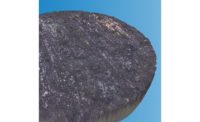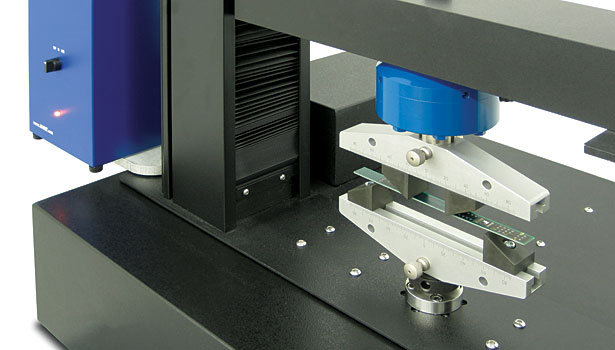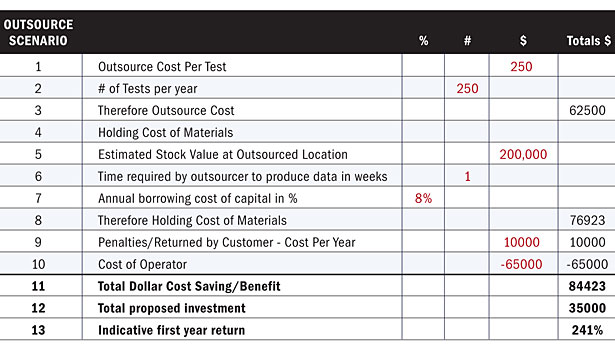Test & Inspection
Manage Materials Testing Costs
How to calculate ROI and justify an investment in a materials testing system

Materials testing machines may be used for bend tests, as seen here. Source: Admet

The outsourcing costs are examined here. Source: Admet, Red text = user input

The costs are a replacement system are considered here. Source: Admet, Red text = user input



When talking with prospects and customers, testing machine manufacturers often come across symptoms that imply the current situation could be improved dramatically with a new investment in technology, specifically a well-engineered materials testing system. The problem often surrounds the ability of local management to persuade the budget holder to release funds for the investment.
The first thing to state is that senior management is motivated by the return on their capital far more than whether a budget exists. There are many items in a budget that are never spent. Every major expenditure that a company makes is driven far more by the return on that investment than it is by whether it is covered by a budget. So the key is to build a credible Return on Investment (ROI) paper that decision makers relate to and is comparable to other prospective investments they might make. In the materials testing system world there are two obvious scenarios.
Scenario 1: Outsourcing
In this scenario the company outsources its material testing needs to an outside testing laboratory. The key components to an ROI calculation are as follows:
- The cost of each test
- The number of tests done per year
- The value of stock tied up at the outsourcer
- The cost of borrowing of the company
- The time required by the outsourcer to do the tests
- Penalties historically incurred (if any) due to deadlines being missed
- Assumed cost of an operator to run the new machine
- The potential investment in a new system
By bringing these components together as illustrated in the following spreadsheets, it is possible to demonstrate in most cases an ROI percentage in excess of 100%.
Line 3 produces the total outsourced cost for the year by multiplying the number of tests by the cost of each test. Line 8 produces the cost of holding material while we wait for the test to complete. This involves estimating the value of materials tied up, the number of weeks it is held in stock waiting for the test to be completed, and the annual cost of borrowing of the company. So in this example $200,000 is multiplied by 8% multiplied by 1/52 to arrive at $76,923. Line 9 is an estimate of penalties incurred in a year due to deadlines being missed. Line 10 is the estimated annual cost of an operator to manage the new machine. The ROI percentage is calculated by dividing the total net cost savings, line 11 by the total cost of investment, line 12 to arrive at 241%.
Scenario 2: Replacement System
In this scenario the company is considering replacing aging equipment with a new material testing system with full automation. The key components to an ROI calculation are as follows:
- Estimated current time to complete a test
- Expected time to complete a test using the new system
- Number of tests performed each day
- Cost of an operator per hour
- Dollar value of shipments in a year
- Time lost in hours per year by using the aging current system
- The percentage of lost revenue per year
By bringing these components together as illustrated in the accompanying spreadsheet, it is possible to demonstrate in most cases an ROI percentage in excess of 100%.
Line 10 produces a total cost saving by generating the time saved in minutes each day, by using the new machine, line 5, extrapolating that to time saved in hours per year, line 8 and multiplying by the operator cost per hour, line 9.
Line 16 produces the lost revenue figures related to the lost time by using the aging machine. Note this lost time at line 12 is the same time we worked out at line 8. We convert the lost time in hours per year into days, then based on 240 days in this example, we derive an percent of lost revenue, line 15. In this case we lost 3% of the annual shipments due to lost time which is 3% of $3 million or $75,000. The ROI percentage is again calculated by taking the total benefits, line 17 and dividing by the total proposed investment, line 18 to arrive at an ROI percentage of 235%.
It is important to ensure that the assumptions made are realistic and that the author of the ROI paper owns the assumptions made. By translating the material testing issues into the classic language of ROIs, your proposal will carry far greater weight, be better understood, be comparable with other investment decisions and will lead to better decision making.
Materials Testing Machine Costs
There are multiple costs associated with purchasing and operating a materials testing machine. Before you begin testing, not only do you need to consider the purchase price of the machine, but shipping, installation and site modification costs as well. Shipping costs may run between $500 to $2,500 or more depending on size and weight. If the machine is large and your facility has no clear route between the loading dock and test lab, then you may need to hire a rigger to uncrate the tester and transport the machine to the lab. Rigging costs vary greatly depending on issues like having to traverse stairs or remove a door or window. Prior to placing the machine in the lab, you must also determine if the floor is rated to support the weight of the machine and if you have the required electrical power installed in the room.
Once the machine is installed in the lab, it will need to be calibrated. Many labs have their testers calibrated annually, biannually, quarterly or monthly depending upon requirements. Calibration procedures within North America are governed by the American Society of Testing and Materials (ASTM). Common calibration specifications for a universal testing machine are:
- ASTM E4 Standard Practices for Force Verification of Testing Machines
- ASTM E83 Standard Practices for Verification and Classification of Extensometer Systems
- ASTM E1012 Standard Practice for Verification of Test Frame and Specimen Alignment Under Tensile and Compressive Axial Force Application
- ASTM E2309 Standard Practices for Verification of Displacement Measuring Systems and Devices Used in Materials Testing Machines
Several testing machine manufacturers have their own captive calibration organizations. Other manufacturers work with a network of regionally located independent service calibration businesses. The independent service providers are less expensive, sometimes half the cost, of the manufacturer based providers. In addition, they are usually more flexible on schedule.
Start-up training is included in the purchase price of most testing machines. The experience of the testing machine operators usually dictates how much training is required. You should plan on one day as a minimum. The variety and complexity of the tests and the features included in the software/controller are other factors that dictate how much training is required. One person should be appointed as the technical liaison between the testing machine operators and machine manufacturer, as in the event you experience issues with your tests, the technical liaison will be more efficient in helping the manufacturer to resolve your problems. One other consideration is the turnover of your testing machine operators and how much training the replacements require. Will the technical liaison be able to provide training or will the manufacturer need to be brought in at additional cost?
Testing machine maintenance can be as simple as keeping the machine free of broken sample fragments and periodically lubricating moving parts. Additional maintenance may be required if, for example, you are performing tensile tests on very hard and brittle materials. Extensometer knife edges may require replacement and grip faces typically need frequent cleaning and/or replacement. When considering software upgrades, verify that the software is compatible with your computer operating system. Some upgrades may require you to add more memory to your computer. If your testing machine software/controller is old, replacement may be the only upgrade option. If you find yourself in this situation, not only should you explore upgrade options with the machine manufacturer but you might want to discuss your upgrade options with other vendors. Oftentimes, you will find an upgrade from a vendor other than the machine manufacturer better fits your needs, is easier to use, and costs less.
|
TECH TIPS
|
Looking for a reprint of this article?
From high-res PDFs to custom plaques, order your copy today!







